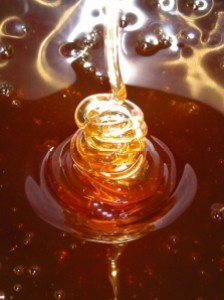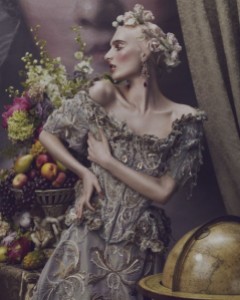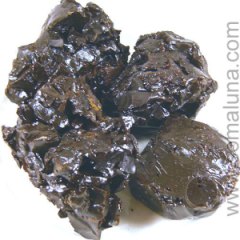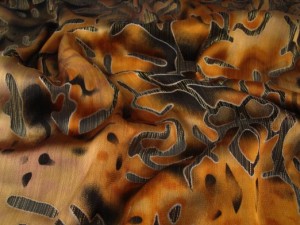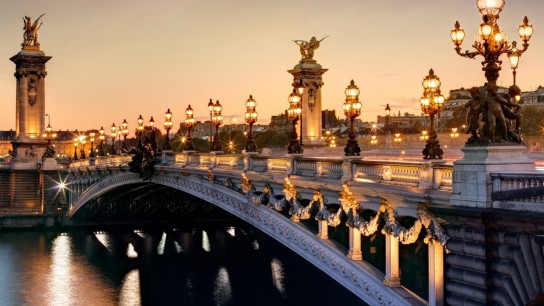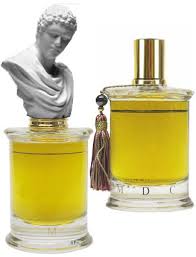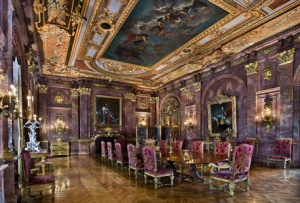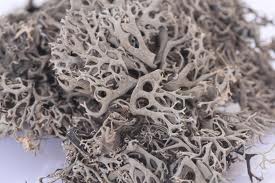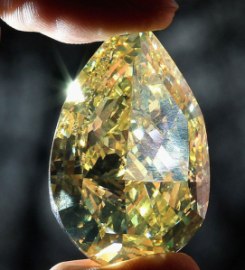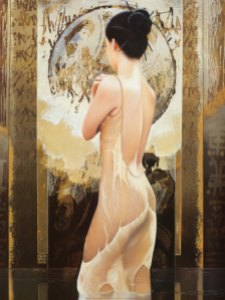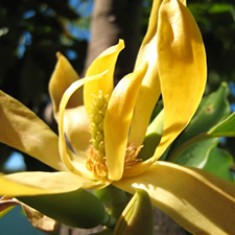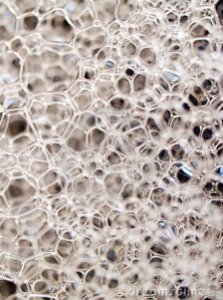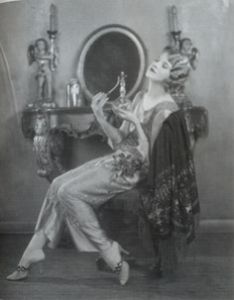Welcome to the jungle, as Axl Rose would say. Somewhere, perhaps in Paraguay, Africa, or Mongolia, a leather and fur-skin clad hunter called Montecristo stalks his prey through a jungle filled with tobacco plants and Cabreuva trees smelling of lemony florals. The trees are sprinkled with red chili pepper, cumin and costus root, then heavily blanketed in honey. The ground is a soft field of creamy brown from ambrette shrubs that waft a warm, vegetal, muskiness sweetness. They too are covered with honey. Scampering through the vegetation is the fluffiest, most adorable animal imaginable. He occasionally stops to pee on all the bushes, emitting a sharp, feral “YEOOWWL” in happy relief, as his scent swirls with the honey, spices and tobacco.
On his heels is the hunter whose heated skin and sweat stains the rough leather of his vest. The chase is hopeless, our little rodent is too fast, and the hunter goes home. Covered with honey, he’s dirty and skanky from his exertions, and his musky skin is stained with traces of tobacco and sweaty leather. As he sips a glass of rum, his wife sponges him off lightly, leaving a mix of cleanness and animalism on his warm skin, before she takes him off to bed to make love.
The adventures of Montecristo the Hunter are the adventures at the heart of the latest masculine, niche fragrance from Milan. Montecristo is an eau de parfum from Masque Milano, or Masque Fragranze as it is written on their website. (The house is better known as Masque Milano, so that is what I shall call them from this point forward.) The company is a relatively new, and was founded in 2012 by two close friends, Riccardo Tedeschi and Alessandro Brun.
They see their fragrances as operas in several acts, even calling their brand at one place on their website: “Masque Fragranze – the Opera of life in four acts.” They add:
With Masque Fragranze, Alessandro and Riccardo do not intend to create a myth, a best-seller, a one-size-fits-all perfume for everyone. Rather, they aim at creating a collection of perfumes with a soul. Each one unique. Perfumes to wear like a second skin … the perfume behind the mask. […] The fragrances of Masque are to be created with a soul, and the nose’s appointment is to give life to our scene. Hence, every scene will have “its” nose.
In the case of Montecristo, an eau de parfum which was released late last year in 2013, that nose is Delphine Thierry. On their website, Masque Fragranze describes Montecristo and its operatic screenplay as follows:
I – II
MONTECRISTO
In the livingroom of an old villa, in the Tuscan countryside.
It is the close of day.Act I scene two
Every single element of the interior contributes to the warmth and reassuring comfort. The floor of old robust wood planks, aged and worn with the use. In the massive fireplace, coals are still burning. The comfortable couch is made of the best leather, once stout and rigid, and spotlessly tanned, is now soft and worn, and the colour is fading away. A deck of used playing cards abandoned on the coffee table. The tobacco leaves of the hand rolled cigar. A glass of rum.Head Notes
Cabreuva, Ambrette Seeds, RumHeart Notes
Tobacco Leaves, Celery Seeds, Cistus [Labdanum], BenzoinBase Notes
Golden Stone [Hyrax], Styrax Gum, Gaiac Wood, Cedar Wood, Patchouli. [Emphasis in bolding added by me.]
Two of those notes leapt out at me as something totally alien, so I did some research. As it turns out, those two ingredients play a big role in terms of Montecristo’s development on my skin, so I’ll take some time to explain what they entail. Apparently, “Cabreuva” is a type of tree found primarily in Paraguay. The aromatherapy site, White Lotus Aromatics, explains its smell and perfume uses:
The essential oil of Cabreuva (Myrocarpus fastigiatus) is a pale yellow liquid displaying a delicate, suave, sweet woody bouquet with a balsamic, floral undertone of good tenacity. […][¶] It is highly valued as a low cost fixative.
“Although very delicated and apparently faint, the odor of Cabreuva oil is often under-estimated in its effect of freshness and suave floral notes. In rose, lily of the valley, cassie, ambre and in woody-oriental perfumes, Cabreuva lends teancity and distinct notes of ‘precious wood’ with a background of slightly green, dry floralness, a combination rarely found in synthetic perfume materials.” Steffen Arctander
I have absolutely no idea what “golden stone” may be as an ingredient, and Google yielded nothing that applied, but the note appears to be what Fragrantica lists as Hyrax on its Montecristo page. According to its Hyrax definition entry, the hyrax is a small, adorably cute rodent whose feces have a super useful purpose in both ancient and modern perfumery. The Hyrax is the single, most important element in Masque Milano’s Montecristo, so bear with me as I quote from Fragrantica:
Odor profile: essence from the small rodent hyrax’s dried up crystalline fecal matter, combining olfactory facets of musk, civet and castoreum. Invaluable in a time when animalic essences derived by cruelty are banned. [¶]
Hyraceum, or Hyrax, is an aromatic raw material of the antique perfumery. However, men used this material much before they started to use it in perfumery. The African tribesman and people of the Middle East used Hyraceum as a traditional remedy for epilepsy, kidney problems, convulsions and feminine hormonal disorders. [¶] This substance is actually the petrified and rock-like excrement formed from the urine of hyrax. Hyraceum is fairly sterile, stone-hard material that also contains pheromones[….]
In perfumery, we use very old, fossilized, dry and stone-heavy Hyraceum, which is typically over hundreds if not thousands of years old. It gives an animalistic, sensual and deep note that feels like a combination of musk, civet, castoreum, tobacco and agarwood. Because of its characteristic structure, this material is also known as Africa Stone. Earthy, rich and resinous[….] Last but not the least, no animals are harmed in making this material. [Emphasis added by me.]
When I smelled Masque’s Montecristo in the vial, I was struck by the softly lemony, floral musk aroma and how it glittered with drops of golden honey. Taking a deeper sniff, I could immediately see the feral yeowl in the back, but the primary impression was a lemon-infused “slightly green, dry floralness,” as quoted in Cabreuva’s description up above. When you apply a small dose of Montecristo on the skin, that bouquet continues to be very dominant, though it is not the main player by any means. It’s quite another story, however, if you apply a lot of Montecristo; in my case, about 3 good smears amounting to more than 1/4th of a 1 ml vial, or about the equivalent of one spray from a bottle. This review will focus primarily on what happens in that situation.
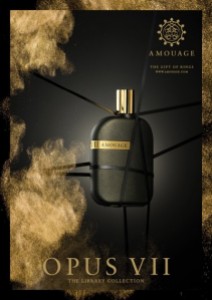 Montecristo opens on my skin with a lightly floral, woody muskiness, but the fluffy, cute hyrax rodent’s yeowl is evident from the start. The animalic notes are urinous, dirty, skanky, raunchy, and every other adjective that you can possibly imagine. I was immediately struck by the thought of vintage Kouros, and, to a much lesser extent, Amouage‘s Opus VII. Parts of what I wrote in that review apply here as well, as Montecristo’s scent is
Montecristo opens on my skin with a lightly floral, woody muskiness, but the fluffy, cute hyrax rodent’s yeowl is evident from the start. The animalic notes are urinous, dirty, skanky, raunchy, and every other adjective that you can possibly imagine. I was immediately struck by the thought of vintage Kouros, and, to a much lesser extent, Amouage‘s Opus VII. Parts of what I wrote in that review apply here as well, as Montecristo’s scent is
urinous, like animal droppings, but also musky with a faint tinge of dirty hair underneath and [lemony nuances]. […] [The] sharply animalic note — often described by some as resembling “urinal cakes” — makes vintage Kouros a deeply polarizing fragrance. I suspect the same will be true of Opus VII. … [As a whole,] it is a deeply woody-leathery fragrance that feels quite smooth, with a savagely sensuous heart at its base and something that seems almost like a velvety floral.
Both vintage Kouros and Opus VII contain costus, an animalic base created by Symrise. There is no such note listed in Montecristo, but hyrax was described up above as having an aroma that combined the olfactory profiles of civet, castoreum, and real musk, presumably of the original Tonkin deer musk variety. So, if you’re familiar with any of those aromas, or with Opus VII, then you will have a definite idea of the main note in Montecristo’s opening hour. However, I should add that the costus-like aroma in Montecristo is substantially weaker than what I experienced with Opus VII. There, it was so intense and sharp that I described feeling as though a lion had peed on me and then dragged me through the Wild Cat enclosure at the zoo. Montecristo is nowhere as extreme, thank God, as I found Opus VII well-nigh unbearable. In contrast, I truly enjoy every bit of Montecristo’s raunchy dirtiness.
Part of the reason why is because the animalism is much better modulated in Montecristo, but the main reason is due to its combination with the other notes. Sharing center stage with the hyrax musk is deep, potent honey. It infuses every part of the scent with a further animalic touch, but also with a rich sweetness that is almost indolic. My skin amplifies base notes, so I’m not surprised that the honey is so dominant, but I wish I knew where it came from. Cabreuva wood is described as being balsamic, not honeyed, so I’m quite lost. Perhaps it’s a side-effect of the rum, though the note doesn’t feel liqueured to me but more like straight honey.
Lurking underneath it is a quiet spiciness that slowly grows more fiery. It takes less than 4 minutes for something to appear that distinctly resembles dusty cumin, followed by what smells distinctly like a fiery, red chili pepper. There is also a natural, vegetal, very warm muskiness from the ambrette (or musk mallow) stirring deep in the base. More noticeable from the start, though, are the golden leaves of tobacco which weave their way throughout the musk and feel drenched with the honey. Lightly sprinkled on top of the whole bundle is a light, boozy note of rum. The overall mixture is a plethora of warmth, feral sharpness, sharp honey, natural sweetness, tobacco, spices, and vegetal musk.
I find myself utterly transfixed by the animalic muskiness of the hyrax and, more to the point, all the different perfumes that Montecristo calls to mind. The urinous edge to the musk makes Montecristo different than Parfums d’Empire‘s challenging Musc Tonkin which, on my skin, opened with an extremely difficult aroma of hair, fur, fat and unwashed skin. Yet, there is a warmth underlying both fragrances, thanks to their shared note of ambrette. Montecristo feels like a more honeyed, tobacco-flecked, boozy, and ambered version of Musc Tonkin’s later, easier stages, once the fur and fat have died down. On the other hand, Montecristo is different in having the spices, as well as the lingering, extremely muted touches of the Cabreuva’s lemony, floral greenness at its edges.
At the 10 minute mark, the honeyed, urinous raunchiness grows stronger, as does the cumin-chili spiciness, thereby triggering similarities to other fragrances. On both occasions that I tested Montecristo and regardless of the quantity that I applied, the first parallel that arose was Absolue Pour Le Soir by Maison Francis Kurkdjian. Both scents have the same heavily honeyed focus, infused with cumin, leathered undertones, dirty musk, and ambered spiciness at the beginning. There are differences, though, as Montecristo has a chili bite (from God knows where), not to mention tobacco and booze, but no incense or strong florals. With a much lesser quantity, Montecristo’s more tobacco-centered bouquet reminded me of a distant cousin to Serge Lutens‘ Chergui. A very distant cousin, as this would be an animalic, feral Chergui with spices, more amber, a thousand times more honey, darker woodiness, and no powder.

Special, limited-edition, rare bell jar bottle of Muscs Koublai Khan. Source: Serge Lutens Facebook page.
The main resemblance, however, is to another Serge Lutens fragrance: the magnificent, complicated, notorious Muscs Koublai Khan. If you apply only a small quantity of Montecristo, the musk smells similar, perhaps because the shared ambrette note, though the Masque Milano version is significantly sweeter with that powerful, animalic honey. If you use more, then Montecristo’s urinous, costus-like side is much fiercer, sharper, and rougher than it is in Musc Koublai Khan, not as smooth or refined. The more obvious, early differences are the tobacco, boozy rum, and that odd, inexplicable spice mix of cumin and chili pepper tonalities. Yet, once Montecristo’s opening mellows out and smoothens, especially three or four hours in, then the similarity to the Lutens is much closer. Perhaps the best way to sum up Montecristo’s first two hours on my skin is as a combination of Musc Koublai Khan, Absolue Pour Le Soir, and Serge Lutens’ Miel de Bois, before it eventually transitions into something more like Musc Koublai Khan mixed with lemony oud, dark resins, and leather. (We’ll get to those notes shortly.)
All this talk of Absolue Pour Le Soir brings me to another point: honey and skin chemistry. Honey — whether real or the side-effect of another note — is one of the trickier elements in perfumery. On some skin, it can turn screechingly sharp, akin to cat pee, plastic, or both. On others, however, it blooms. I happen to be one of the lucky ones, with the rather glaring exception of Miel de Bois. The one time I tested it was a rather horrific experience, though I plan on giving it a thorough, full assessment at some point in the future. My point, though, is that you may want to keep the skin chemistry issue in mind if you’re curious about Montecristo but don’t know how your skin traditionally deals with honey. And, as should obviously be clear by now, if you can’t stand any sort of animalic, dirty musk, or cumin notes in your perfumes, you will want to give Montecristo wide berth.
If the discussion of animalic honey and musk, costus, feral notes, rodent pee, cumin and the rest has you alarmed, well, Montecristo is a lot more balanced than you’d think. The perfume moves a bit like the shape of an “M” on a graph, where it opens softly, builds up mere minutes later, and feels pretty ferocious after 15 minutes. Yet, even at that point, changes are occurring to soften the impact, counter the animalic “Yeowl” that I keep referencing, and start the transition downwards to something much more approachable in nature. A quarter of an hour in, a soft, almost powdered creaminess stirs in the base. It’s lovely, reminding me of white honey beeswax butter or cream. Slowly, very slowly, it helps to take the edge of the urinous raunchiness, diffusing its slightly acidic sharpness. Also making its first appearance is a dried woodiness that, at lower doses of Montecristo, had a distinctly oud-like aroma.
It takes exactly 28 minutes for Montecristo to lose some of its ferocity on my skin, and to begin the slow transition to a smoother, less aggressively sharp fragrance. All the same elements are there as in the opening, but the raw, hard edges are being coated with a honeyed creaminess and satiny mellowness. I really think the ambrette plays a large part in all this, as its musky aroma is of the ultra-smooth, vegetal, plush variety. For me, its warmth is akin to the real scent of human skin, but clean, warm, skin the way it after a long, deep nap under a thick blanket. Montecristo’s musk isn’t at that stage yet, but it does show the first touches of a baby-soft, human fuzziness about it.
If I’m not talking loads about the tobacco, it’s because it really wasn’t the dominant note on my skin. In neither of my two tests of Montecristo did it trump the musk. In fact, the tobacco felt significantly weaker when I applied a greater quantity of Montecristo, as the honey and animalic musk were amplified.
At the end of the first hour, Montecristo turns softer in weight, density, and silage. The perfume is now a cloud radiating 2-3 inches above the skin, as soft as a baby’s chenille blanket in feel. It is primarily a warm, vegetal, sweet musk that really evokes for me the feel of human skin. It is still urinous and animalic, but the dirty side is much softer, more muted and smoother. With every passing quarter-hour, the urinous edge seems to take another tiny step back to the sidelines to join the tiny dabs of tobacco, boozy rum, and that rather nebulous whisper of woodiness.
As a whole, the musk feels much more velvety, deep, and creamier than it is in Serge Lutens’ Muscs Koublai Khan (“MKK“). What I can’t seem to decide is whether the note is more or less feral than it is in the Lutens at a similar stage. In other words, the degree of pee. (The MKK was never fecal on my skin as it is on some people.) At various points in my notes, I wrote that Montecristo’s urinous yeowl softens much, much sooner than the same note does in MKK. On my skin, MKK has a quieter urinous, dirty, musky note at the start, relatively speaking, but it seems to last much longer than it does with Montecristo. In fact, when I wore MKK this summer, the feral bits were very sharp on me at times as well.
Yet, every time in the first few hours that I think that Masque’s Montecristo has settled into something not as animalic, something that is closer to the fuzziness of MKK’s later stages on my skin, something happens to make me change my mind. The urinous edge fools me, repeatedly, into thinking that it has receded. To be clear, it lasts almost to the very end, but I’m talking about how dominant it is, how long it takes for it to feel less of a dominating presence, and the time it takes for Masque’s Montecristo to approach the softer, “human skin” stage of the Lutens. All I can firmly say is that, as a whole, the musk in the Lutens feels thinner, lighter, and without the creaminess that I sense in Montecristo.
At the 90 minute mark, Montecristo turns drier and darker. The honey is much less dominant, and is folded into the musky base as a whole. The urinous edge is more muffled in feel, as are the tobacco and cumin. The rum and chili pepper have completely vanished. In contrast, the abstract woodiness starts to rise to the surface, along with that growing flicker of something oud-like. After 2.5 hours, Montecristo is a soft, animalic, vaguely dirty, sweetened scent with great warmth, ambrette musk, and leathery accents, all atop an amorphously woody base. Only the lightest touch of honey and tobacco lurk in the background. The perfume also hovers just above the skin at this point, and very weightless in feel.

Raw leather being tanned in Morocco. Photo by Burrard-Lucas via http://www.burrard-lucas.com/photo/morocco/leather_tanning.html
What is interesting throughout Montecristo’s life is the leather undertone. It is never full-on or strongly black leather, but, rather, an impression resulting from the hyrax’s castoreum-like side. And its prominence fluctuates quite sharply. In the opening minutes, Montecristo has a definite whiff of something that made me think of the raw, uncured, animalic hides in Montale‘s Aoud Cuir d’Arabie. The note was quickly subsumed with the general, costus-like, urinous swirl of dirty animalism, but the leather was a definite subtext in the first hour. By the end of the 3rd hour, however, the leather feels unbelievably supple, lurking under the warm muskiness in a way that simply magnifies the latter. The softened, leathered castoreum also makes the warm musk feel incredibly velvety, evoking the feel of heated skin, perhaps after sex. A few hours later, however, the leather regains some rawness, but it’s a rather fluctuating dance back and forth. In all cases, the leather is only an undertone on my skin, and a rather quiet one at that.
Montecristo is beautifully blended, and the notes feel quite seamless at times. I think that explains, in part, the variegated nature of the leather, but it’s not the only note that fluctuates. Once the intensity of the honey dies down, the cumin reappears as well, but this time it’s quite different. Instead of smelling merely like dusty powder in some Moroccan souk, the cumin smells lightly dirty. I don’t want to say “body odor,” because I don’t want to give the impression that the note smells like sweaty, hairy armpits. It doesn’t. It also doesn’t carry a stale, fetid, aroma of someone who hasn’t washed in days. I swear, it really doesn’t. But, yes, there is no getting around the light, earthy whiff of a body scent. God, I can see half of you stampeding for the door by now, as this is probably the very last straw in this whole Montecristo saga. If it makes any difference, it’s all very subtle. I mean it quite sincerely when I say that, if you can handle the cumin note in Absolue Pour Le Soir, you should have no problems with it here.
Montecristo continues to turn darker and woodier. By the end of the 5th hour, the Cabreuva’s lemony touches return, though they now feel underscored by a very fragrant, balsamic, dark resin. The slightest touch of something nebulously floral lurks at the edges, but much more noticeable is the almost agarwood-like nuance to the wood. As a whole, Montecristo increasingly smells of a lemony, slightly oud-like, vaguely dusty, resinous woodiness infused with a warm musk that is simultaneously vegetal and slightly urinous. The honey has been folded within; the tobacco briefly returns before flitting away again; and the leather fluctuates back and forth in strength, smoothness, and prominence. Montecristo remains weightless in feel, and continues to hover just above the skin, requiring little effort to detect its nuances if you bring your arm near your nose.
It takes about 9 hours from the opening for Montecristo to turn into truly fuzzy musk scent. It is soft, warm, and sweet with just a slight powderiness underlying it. The texture is lovely, as it feels as soft as a petal. Now, finally, it becomes harder to detect, though Montecristo had turned into a skin scent somewhere near the end of the 7th hour. Montecristo turns more and more into the scent of sweetened, slightly heated human skin with a tiny touch of powderiness. It finally fades away on the same note, just over 14 hours from the start. I thoroughly enjoyed every bit of its dirtiness and multi-layered complexity, finding its fluctuating, morphing levels to reflect great technical skill, and I remained fascinated with its nuances from start to finish.
There are already a handful of reviews for Montecristo, mostly from people who are drawn to this sort of fragrance to begin with and, as such, they are all very positive. Though I’ll get to the blog reviews shortly, I actually think the forum analysis from places like Basenotes and Fragrantica provides more useful, detailed or comparative information. One early Basenotes thread lovingly called Montecristo a “skanky, little monster,” and the poster, “Alfarom,” talked about Serge Lutens’ MKK:
The opening is literally arresting. A skank overload provided by a thick amount of hirax and other animalic musks. It immediately brings to mind of the fecal opening of MKK but whereas the Lutens morphes into a floral rosey thing, Montecristo gets all dark and moody with tobacco, resins and some of the darkest patchouli ever. Boozy / balmy notes lurk in the back providing some smoothness to an otherwise extremely challenging fragrance. The result is fascinating to say the least. The fragrance is pervaded by a warm animalic vibe throughout. Sort of a mash up between Lubin’s most oriental offerings and heavy animalic musks fragrances a-la Musk Tonkin and MKK.
On Fragrantica, there is similar talk about MKK. One commentator, “deadidol,” had a very different experience than I did with Montecristo, and you may find his wonderfully detailed review to be quite helpful. It reads, in part, as follows:
This has a super dirty opening of hyraceum and ambrette seed that could give MKK a run for its money. But whereas MKK is very civet-based, this leans more toward the sweatier side of things and will certainly challenge those who don’t fair well with hard-core musks. However, within ten minutes, it takes a massive detour into an unconventionality that’s wildly evocative and decidedly convincing in the associations it brings up.
There’s a booze note (rum), but it’s more like the smell of booze that’s oozing from the pores of someone who downed the bottled a few hours ago—it’s got an unnerving filtered feeling to it. […] There are some relatively undefined wood notes, but combined they smell more like old bookshelves and furniture; and there’s something here that gives the impression of an extinguished fire as well. Imagine a poorly ventilated space that’s been coated with a layer of sticky, smoky, charcoal-type residue—a slightly sweet ashy scent, but mixed with dust that’s sat for days to produce a not unpleasant staleness that’s completely comforting. Frankly, it’s quite hard to perform a technical dissection of Montecristo as it’s evoking space more than individual notes, and it’s doing so phenomenally well.
So, this is a dusty, rustic, vaguely reminiscent scent that feels as though you’re looking into its world through an opaque piece of glass. Everything in it seems peculiarly distanced, yet it all comes together in a sublime way. I don’t know how wearable this would be for most people as it almost smells stagnant, but it’s hugely compelling and surprisingly cozy. If you’ve ever been drawn to parchment type scents (or perhaps the smell of old bookstores), or you like the challenge of a good ambrette seed musk, this is absolutely sui generis, and for me, it’s the best scent of 2013 hands-down.
There are female commentators on Fragrantica who seem to like Montecristo too, though there are only a handful of them thus far. One of them initially wrinkled her nose and thought, “this is way too much” but further testing changed her mind: the “more I test “Montecristo”, the more I adore it.” She calls it “a superb example of a true niche perfumer” that is “complex and dramatic.”
In terms of blog reviews, one of the more detailed ones comes from Fragrantica itself, where Serguey Borisov talks at length about the hyraceum and has a very evocative description of Montecristo. The piece is long, so I’ll quote the more relevant parts beginning with the images which Montecristo evokes for him. As you will note, he had a similar experience to “deadidol” on Fragrantica in terms of the perfume’s dusty woodiness:
An old clay mug with rum or whiskey stands on the table, an old sagging leather chair with cracked, scuffed and greasy arms, an old dog lying on the bearskin in front of it. Animal head trophies are on the wall—heads with the fangs, horns and ears. An old hunting rifle is positioned next to them. The entire room smells of animal musk, clove buds and dusty mineral particles which are reminiscent of gold or diamonds.
This is what the home of a troubled man smells like. The man had to be a priest and a soldier, a hunter and his prey, a miner and a night watchman. He lived so many different lives, with every single one’s own story written on his face. […]
Montecristo has a special animalic aura. It’s goaty smell is similar to costus or Symrise’s animalic base. [Hyraceum’s] scent is elegant and reminiscent of musk, castoreum, oud and civet. […][¶] It’s a wild and animalic nuance, it’s uncivilized and dangerous and as vague as dark shadows in a nocturnal forest. Wild, intense and smelly aromas make Montecristo just as dirty and brutal as Oud Cuir d’Arabie by Montale, but more bitter and more mineralic. The opaque brown formula, the scent of goat, resins and the bitterness of patchouli—that’s what distinguishes Montecristo from conventional incense perfume. Plus, it was strengthened with Iso E Super and musk.
I truly don’t detect ISO E Super in Montecristo, and I’m usually a weathervane for the bloody note. If it’s there, I don’t think it’s responsible for that vaguely oud-like smell to the wood. Serguey Borisov says the hyrax can be reminiscent of oud, so that’s the probable cause. I don’t detect any of ISO E Supercrappy’s usual troublemaker aromas; not its “pink rubber bandages,” its lemony-woody buzz, its antiseptic notes, or its basic, simple, dry pepperiness. There is also nothing which gives me a searing headache, so if there is ISO E crap in Montecristo, it has to be the most infinitesimal drop around.
The Non-Blonde loved Montecristo passionately, calling its complexity “mind boggling” and writing, in part:
I can’t imagine the reaction of an average perfume buyer to Montecristo by new(ish) perfume house Masque Milano. I just can’t. This is not the perfume to wear in close quarters with the uninitiated, because you will get The Look, I guarantee.
There are too many perfume brands and too many perfumes on the market. Very few of them offer anything new, even fewer come up with anything exciting that gets added to my “Must.Get.Bottle.Now” list. I just ordered my third sample set of Masque Milano perfumes, but I already know that Montecristo is going to be in my life from now on. Because it’s that good. That sexy. That fascinating.
As you’ve probably figured out by now, Montecristo is an unabashedly animalic perfume. The main culprits are two: ambrette seed with its expensive but unwashed musky vibe, and hyrax or hyraceum, which is basically fossilized pee of a cute rodent (completely cruelty free). The complexity of this animalic combination is mind boggling. It reminds me of really good civet, gorgeous intimate musk, the dirtiest part of exquisite oud, and a general air of debauchery. […] Montecristo is, indeed, dirty and slightly sweaty (cumin isn’t listed anywhere, but I swear I can smell traces about four hours into its wear-time) , it’s also warm, very boozy, leathery and intimate. It holds you close and tells you its interesting life story all through the night [….][¶] Montecristo is still there the next morning.
I share her opinion on the fascinating nature of Montecristo. Even more so, on how it would make average perfume buyers run screaming for the cliffs, then jump off. (I could see the survivors later burning any clothing that Montecristo happened to touch.) Montecristo is probably not a perfume even for someone well-versed in niche perfumery, unless they have a definite taste for animalic, dirty, leathered, goaty scents that skew very masculine. In short, this is a perfume for those with very specific tastes. I personally would wear it if I owned it, without a doubt. But I am hesitant as to whether I would ever buy it for myself.
The reason is probably not what you would expect: it’s Hard Leather. The LM Parfums‘ animalic creation is my absolute favorite fragrance in recent years, and nothing is going to budge it from being at the very top of my list. If I have the need for honey-covered animalic, raunchy leather with muskiness, spice, oud and woodiness, I’ll turn to my precious bottle of Hard Leather. The perfume is more obviously leathered, has much more oud, and massive amounts of incense as well. Much more importantly, it has heaping mounds of almost impossible-to-find, genuine Mysore sandalwood from start all the way through to its gorgeous finish. The animalic notes in Hard Leather are much smoother, more refined and better calibrated than the Montecristo; the Masque Milano fragrance has a significantly more feral core, is much more urinous, and is also much sweeter. Plus, can I repeat my swoon over Hard Leather’s heaping, walloping, galloping amounts of genuine, rare Mysore sandalwood? Not a nary of a whiff of that in Montecristo.
For me personally, Hard Leather is also more versatile and easier to wear. Its dirty raunchiness is much more limited and refined in scope, so I would have no problems wearing it every day if it were not so expensive. In contrast, Montecristo is much more focused on the feral hyrax from start to finish. When you throw in the powerful role of the honey in Montecristo, the result is a scent that is best suited for special occasions, not everyday ones. Then again, I also think that way about Absolue Pour Le Soir, which is another fantastic scent, so that isn’t a slam.
If Hard Leather didn’t exist, I would absolutely consider Montecristo because I really think that it’s a super fragrance. It has phenomenal longevity, really good sillage, complexity, depth, and sexiness. It’s also not too bad in price: 100 ml of eau de parfum costs $215 or €150, which is substantially less than Hard Leather. So, if you ever wanted a mix of Absolue Pour Le Soir (APLS) and Muscs Koublai Khan (MKK), with a small shout-out to Opus VII from the costus-like raunchiness and a nod to the rawness of Montale’s Aoud Cuir d’Arabie, then you should give the Masque Milano fragrance a sniff.
Otherwise, I would advise extreme caution. I have to emphasize as vociferously as I can that Montecristo is not for everyone. In fact, I think a lot people would struggle with it, unless they are APLS, MKK, and Hard Leather fans. I also think that Montecristo skews highly masculine. Women who don’t appreciate skanky, dirty, leathered or masculine fragrances will probably be repulsed by the urinous aspects evident here. For this perfume more than for most, skin chemistry is also going to be paramount. It’s really going to determine just how extreme some of the nuances are on your skin, from the hyrax’s dirtiness to the animalic honey and cumin.
If all goes well, hopefully, you’ll be taken to the jungle with Montecristo the hunter. If it doesn’t, don’t say that I didn’t warn you.








